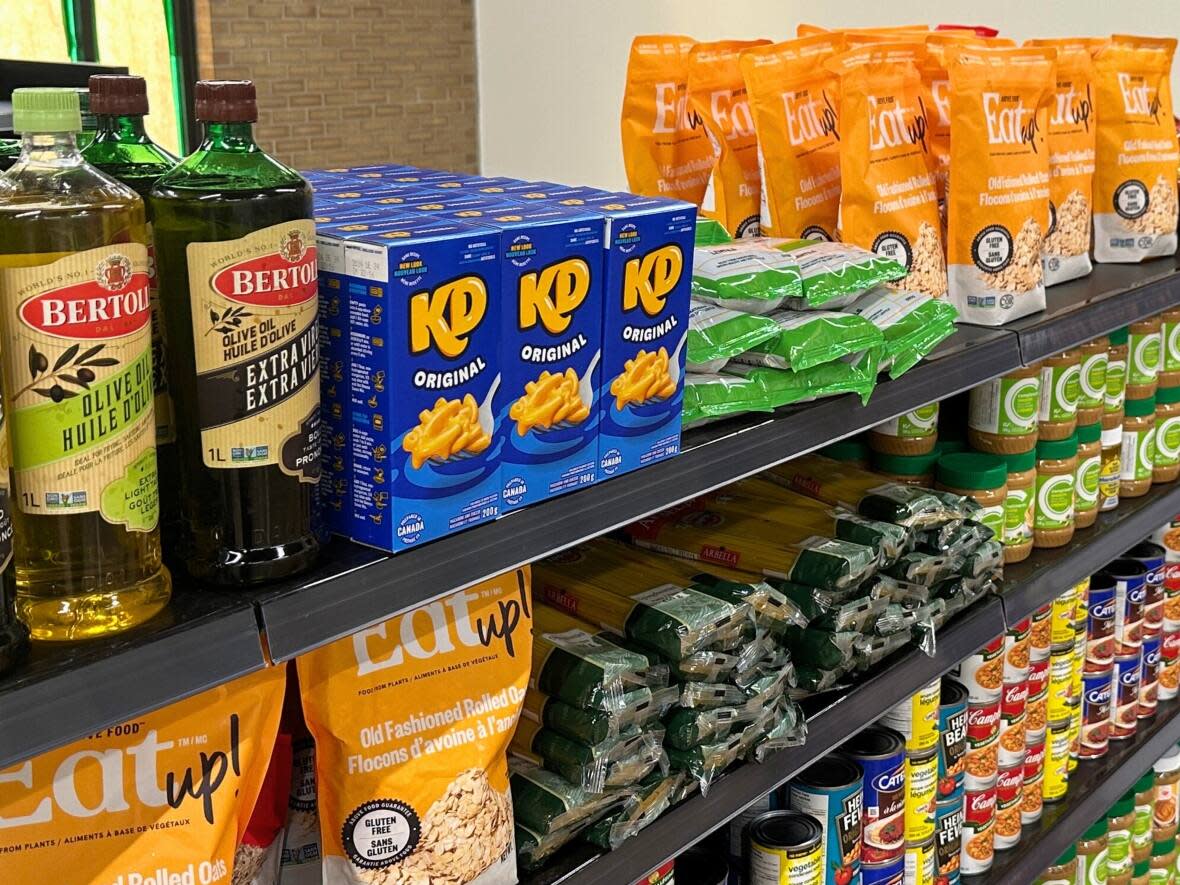Canada's 1st full-scale free grocery store to open in Regina

Imagine walking into a store, picking out all your groceries for the week and not having to worry about facing an expensive bill at the checkout.
For clients of the Regina Food Bank, that will soon be a reality.
Since the pandemic, there has been a spike in food bank users across the country, up 25 per cent in Regina alone. One in eight families — and one in four children — are now food insecure in the city. Of the 16,000 monthly clients, 44 per cent are kids.
The new Regina Food Bank Community Food Hub, modelled after a traditional grocery store, is set to open this summer in the former government liquor store location downtown.

Exploring the 'choice model'
The hub will give those who rely on the food bank autonomy over what they want to take home to feed their families, rather than being handed standardized items.
"None of us fit in a box, but that's what we give our clients today," said Regina Food Bank vice-president David Froh. "When you give choices, you give not just dignity, but actually, we figure we can feed about 25 per cent more people."
That's because clients don't always have a use for all the items they might typically receive.
"Normally I barter with my neighbours and we swap back and forth, so it kind of works out that way. But a lot of people don't do that," said food bank client Jon White.
"So there's a lot of stuff that just goes to waste."

White first reached out to the food bank for help five years ago, after a shoulder injury left him unable to work. He was consulted on the Community Food Hub, and said his focus was on expressing the needs of fellow clients, which vary. As a bachelor, he said he likes to cook no-fuss meals, like pasta, while a family with kids may need more produce and meat.
He said being able to pick out his own groceries, in a space that looks like a grocery store, will be more comfortable and less clinical.
"With something like this, it can only get better," White said.
WATCH | Visiting Canada's 1st free grocery store:
Other food banks in Canada have piloted the choice model on a smaller scale, with limited hours and capacity. Most are located in churches or community centres. This full-scale store is the first to provide choice to all clients, five days a week, much like a local grocer.
After looking to some similar models in the U.S., Froh said more spaces like the Community Food Hub are sure to pop up across Canada as well.
"It's the future of food banking."
$5M goal as community funds food bank
The Regina Food Bank bought the building at 1881 Broad St. from the provincial government for $750,000. Froh said he's hoping the $220,000 loan that's remaining will be forgiven by the province.
The food bank doesn't get any government funding for operational costs. It has raised $3.7 million to get the building ready, but the goal is to raise $5 million so that there's money to keep it open.
"It takes gifts large and small to pull off a bold, national first like this," said Froh. "We're asking people to give what they can."
"Every little bit helps," said White. "That's why I'm glad the food bank's here, or I wouldn't make it."

Froh said the food bank has received a wide range of donations, everything from large cheques from corporate partners to coins straight out of children's piggy banks.
He said he hopes Regina families can have a conversation about the food bank around the dinner table.
It's expected that about 5,000 kids will visit the food hub with their schools to learn about nutrition and financial literacy. Currently, about 2,000 students get snacks and meals at school through the food bank.
When someone comes for help, Froh said the food bank just asks a few questions about their source of income and family size.
Once they're registered with the food bank, they will be able to stop in every two weeks, by appointment.
Food bank clients will then leave with about $200 worth of food, per person.

About half of those products will be from Saskatchewan, including lentils, oats, canola oil, locally grown fruits and vegetables, and animal products from Saskatchewan Egg Producers, SaskMilk and the Chicken Farmers of Saskatchewan.
Growing need among full-time workers
Froh expects the hub to serve 200 families a day out of the new location, in addition to the clients served out of the food bank's current location, which will remain open. The hope is to help 25,000 people every month once they're at full-capacity.
Froh said their two largest growing demographics are people who work full time — now 18 per cent of food bank clients in the city — and new Canadians.
"Our clients are our neighbours," said Froh. "They come from every corner of the city and every walk of life."
Living up to its "Community Hub" name, there won't just be a store. Outside, plans are underway for a basketball court, an outdoor garden, seating and a playground.
Froh said he's excited about paving the way with a space that's the first of its kind in Canada, but he said the best part is knowing the impact it will have on clients.
"When people come here, they're going to be met with a smile and they're going to leave with the food they need and that's awesome."


